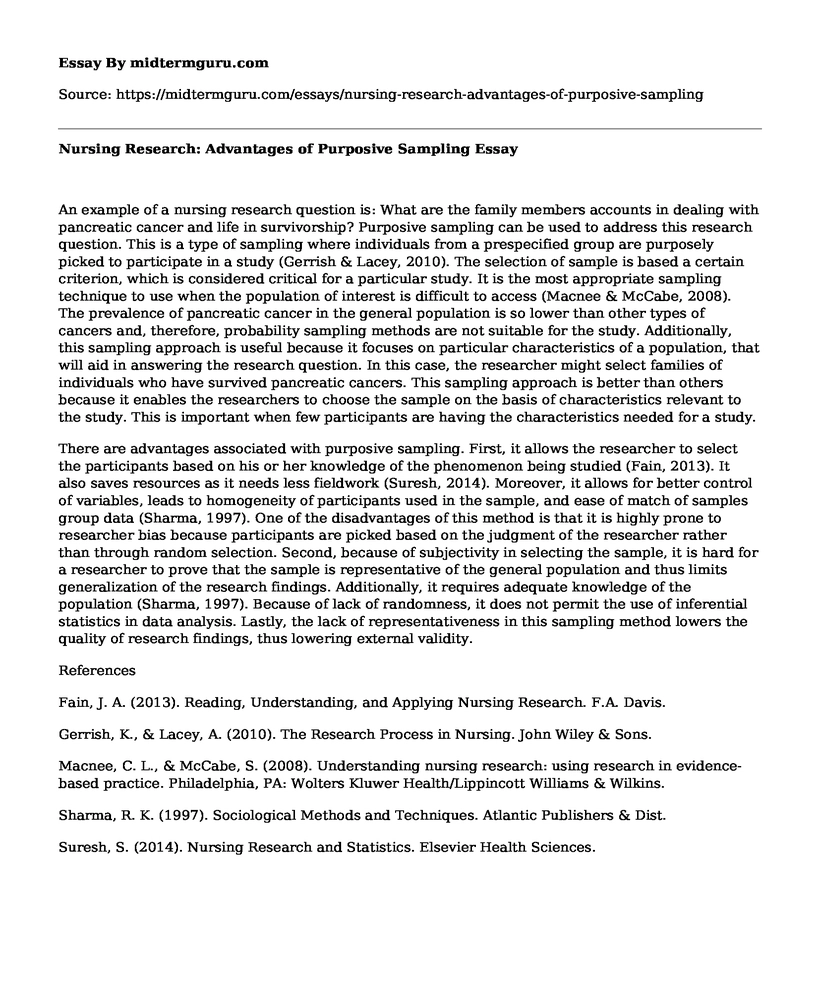An example of a nursing research question is: What are the family members accounts in dealing with pancreatic cancer and life in survivorship? Purposive sampling can be used to address this research question. This is a type of sampling where individuals from a prespecified group are purposely picked to participate in a study (Gerrish & Lacey, 2010). The selection of sample is based a certain criterion, which is considered critical for a particular study. It is the most appropriate sampling technique to use when the population of interest is difficult to access (Macnee & McCabe, 2008). The prevalence of pancreatic cancer in the general population is so lower than other types of cancers and, therefore, probability sampling methods are not suitable for the study. Additionally, this sampling approach is useful because it focuses on particular characteristics of a population, that will aid in answering the research question. In this case, the researcher might select families of individuals who have survived pancreatic cancers. This sampling approach is better than others because it enables the researchers to choose the sample on the basis of characteristics relevant to the study. This is important when few participants are having the characteristics needed for a study.
There are advantages associated with purposive sampling. First, it allows the researcher to select the participants based on his or her knowledge of the phenomenon being studied (Fain, 2013). It also saves resources as it needs less fieldwork (Suresh, 2014). Moreover, it allows for better control of variables, leads to homogeneity of participants used in the sample, and ease of match of samples group data (Sharma, 1997). One of the disadvantages of this method is that it is highly prone to researcher bias because participants are picked based on the judgment of the researcher rather than through random selection. Second, because of subjectivity in selecting the sample, it is hard for a researcher to prove that the sample is representative of the general population and thus limits generalization of the research findings. Additionally, it requires adequate knowledge of the population (Sharma, 1997). Because of lack of randomness, it does not permit the use of inferential statistics in data analysis. Lastly, the lack of representativeness in this sampling method lowers the quality of research findings, thus lowering external validity.
References
Fain, J. A. (2013). Reading, Understanding, and Applying Nursing Research. F.A. Davis.
Gerrish, K., & Lacey, A. (2010). The Research Process in Nursing. John Wiley & Sons.
Macnee, C. L., & McCabe, S. (2008). Understanding nursing research: using research in evidence-based practice. Philadelphia, PA: Wolters Kluwer Health/Lippincott Williams & Wilkins.
Sharma, R. K. (1997). Sociological Methods and Techniques. Atlantic Publishers & Dist.
Suresh, S. (2014). Nursing Research and Statistics. Elsevier Health Sciences.
Cite this page
Nursing Research: Advantages of Purposive Sampling. (2021, May 28). Retrieved from https://midtermguru.com/essays/nursing-research-advantages-of-purposive-sampling
If you are the original author of this essay and no longer wish to have it published on the midtermguru.com website, please click below to request its removal:
- School of Nursing Scholarship Benefits
- Critical Essay on The Gender Trap: Parents and the Pitfalls of Raising Boys and Girls
- Paper Example on Physical Growth
- Paper Example on Drugs And Substance Abuse Among Students
- Paper Example on Integrating Piaget's Classroom Theory Into the Future of Kindergarten
- Rhetorical Analysis Essay: "Is There Pressure on Teenagers to Go to College?"
- Daycare Center Impacts Children's Development: Observations - Research Paper







